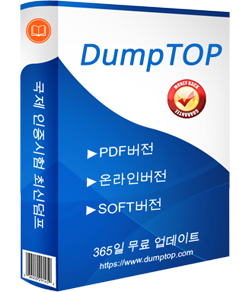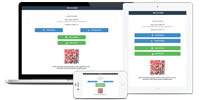시험대비자료는 덤프가 최고
처음으로 자격증에 도전하시는 분들이 많을것이라 믿습니다.우선 시험센터나 인증사 사이트에서 고객님께서 취득하려는 자격증이 어느 시험을 보셔야 취득이 가능한지 확인하셔야 합니다.그리고 시험시간,출제범위,시험문항수와 같은 SnowPro Advanced: Data Scientist Certification Exam시험정보에 대해 잘 체크하신후 그 시험코드와 동일한 코드로 되어있는 덤프를 구매하셔서 시험공부를 하시면 됩니다.DSA-C03덤프구매전 사이트에서 일부분 문제를 다운받아 덤프유효성을 확인하셔도 좋습니다.저희 사이트의 영원히 변치않는 취지는 될수있는 한 해드릴수 있는데까지 DSA-C03시험 응시자 분들께 편리를 가져다 드리는것입니다. 응시자 여러분들이 시험을 우수한 성적으로 합격할수 있도록 적중율 높은 덤프를 제공해드릴것을 약속드립니다.
덤프유효기간을 최대한 연장
DSA-C03덤프를 구매하시면 1년무료 업데이트 서비스를 제공해드립니다.덤프제작팀은 거의 매일 모든 덤프가 업데이트 가능한지 체크하고 있는데 업데이트되면 고객님께서 덤프구매시 사용한 메일주소에 따끈따끈한 가장 최신 업데이트된 DSA-C03덤프자료를 발송해드립니다.고객님께서 구매하신 덤프의 유효기간을 최대한 연장해드리기 위해 최선을 다하고 있지만 혹시라도 SnowPro Advanced: Data Scientist Certification Exam시험문제가 변경되어 시험에서 불합격 받으시고 덤프비용을 환불받는다면 업데이트 서비스는 자동으로 종료됩니다.
IT 업계의 선두자로서 저희의 목표는 IT인증시험에 참가하는 모든 분들께 도움을 제공해드리는 것입니다. 이 목표를 달성하기 위해 저희의 전문가들은 시간이 지날수록 쌓이는 경험과 노하우로 IT자격증시험 응시자분들을 지원하고 있습니다.덤프제작팀의 엘리트들은 최선을 다하여 근년래 출제된 SnowPro Advanced: Data Scientist Certification Exam 시험문제의 출제경향을 분석하고 정리하여 가장 적중율 높은 DSA-C03시험대비 자료를 제작하였습니다.이와 같은 피타는 노력으로 만들어진 DSA-C03 덤프는 이미 많은 분들을 도와 DSA-C03시험을 패스하여 자격증을 손에 넣게 해드립니다.
자격증의 필요성
IT업계에 종사하시는 분께 있어서 국제인증 자격증이 없다는 것은 좀 심각한 일이 아닌가 싶습니다. 그만큼 자격증이 취직이거나 연봉협상, 승진, 이직 등에 큰 영향을 끼치고 있습니다. DSA-C03시험을 패스하여 자격증을 취득하시면 고객님께 많은 이로운 점을 가져다 드릴수 있습니다. 이렇게 중요한 시험인만큼 고객님께서도 시험에 관해 검색하다 저희 사이트까지 찾아오게 되었을것입니다. DSA-C03덤프를 공부하여 시험을 보는것은 고객님의 가장 현명한 선택이 될것입니다.덤프에 있는 문제를 마스터하시면 SnowPro Advanced: Data Scientist Certification Exam시험에서 합격할수 있습니다.구매전이거나 구매후 문제가 있으시면 온라인서비스나 메일상담으로 의문점을 보내주세요. 친절한 한국어 서비스로 고객님의 문의점을 풀어드립니다.
최신 SnowPro Advanced DSA-C03 무료샘플문제:
1. You are tasked with optimizing the hyperparameter tuning process for a complex deep learning model within Snowflake using Snowpark Python. The model is trained on a large dataset stored in Snowflake, and you need to efficiently explore a wide range of hyperparameter values to achieve optimal performance. Which of the following approaches would provide the MOST scalable and performant solution for hyperparameter tuning in this scenario, considering the constraints and capabilities of Snowflake?
A) Employing Scikit-learn's 'GridSearchCV' or 'RandomizedSearchCV' within a single Snowpark Python UDF, processing the entire dataset and hyperparameter search sequentially.
B) Implementing a custom hyperparameter optimization algorithm using Snowpark Python UDFs, manually distributing the hyperparameter search across multiple Snowflake virtual warehouses, and aggregating the results in a central table.
C) Using 'Hyperopt' within a Snowpark Python UDF, relying on its sequential optimization approach without any form of parallelization or distribution of the workload.
D) Using a simple 'for' loop to iterate through a predefined set of hyperparameter combinations, training the model for each combination within a Snowpark Python UDF, and storing the results in a Snowflake table.
E) Leveraging a distributed hyperparameter tuning framework like Ray Tune or Dask-ML within Snowpark Python, utilizing Snowflake's compute resources for parallel training and evaluation of different hyperparameter configurations.
2. You have successfully trained a binary classification model using Snowpark ML and deployed it as a UDF in Snowflake. The UDF takes several input features and returns the predicted probability of the positive class. You need to continuously monitor the model's performance in production to detect potential data drift or concept drift. Which of the following methods and metrics, when used together, would provide the MOST comprehensive and reliable assessment of model performance and drift in a production environment? (Select TWO)
A) Calculate the Kolmogorov-Smirnov (KS) statistic between the distribution of predicted probabilities in the training data and the production data over regular intervals. Track any substantial changes in the KS statistic.
B) Check for null values in the input features passed to the UDF. A sudden increase in null values indicates a problem with data quality.
C) Monitor the average predicted probability score over time. A significant shift in the average score indicates data drift.
D) Monitor the volume of data processed by the UDF per day. A sudden drop in volume indicates a problem with the data pipeline.
E) Continuously calculate and track performance metrics like AUC, precision, recall, and Fl-score on a representative sample of labeled production data over regular intervals. Compare these metrics to the model's performance on the holdout set during training.
3. You are performing exploratory data analysis on a dataset of customer transactions in Snowflake to prepare for a linear regression model that predicts transaction value based on several customer-related features (e.g., age, location, number of previous transactions). You suspect a non-linear relationship between 'customer_age' and 'transaction_value'. Which of the following Snowflake SQL techniques is MOST appropriate for exploring and potentially transforming the 'customer_age' variable to better fit a linear regression model?
A) Create polynomial features by adding 'customer_ageA2' and 'customer_ageA3' as new columns to the table, without checking for interaction effects.
B) Use the window function to bin 'customer_age' into quartiles and treat each quartile as a categorical variable in the linear regression model.
C) Implement a Box-Cox transformation in Snowpark Python, select a suitable transformation parameter based on the data, and apply the transformation on 'customer_age' feature.
D) Apply a logarithmic transformation to 'customer_age' if a scatter plot of 'customer_age' vs 'transaction_value' shows a curve that flattens out as 'customer_age' increases.
E) Calculate the Pearson correlation coefficient between 'customer_age' and 'transaction_value' using the function. If the correlation is low, discard the 'customer_age' variable.
4. A data scientist is tasked with predicting customer churn for a telecommunications company using Snowflake. The dataset contains call detail records (CDRs), customer demographic information, and service usage data'. Initial analysis reveals a high degree of multicollinearity between several features, specifically 'total_day_minutes', 'total_eve_minutes', and 'total_night_minutes'. Additionally, the 'state' feature has a large number of distinct values. Which of the following feature engineering techniques would be MOST effective in addressing these issues to improve model performance, considering efficient execution within Snowflake?
A) Apply Principal Component Analysis (PCA) to reduce the dimensionality of the CDR features ('total_day_minutes', 'total_eve_minutes', 'total_night_minutes') and use one-hot encoding for the 'state' feature.
B) Create interaction features by multiplying 'total_day_minutes' with 'customer_service_calls' and applying a target encoding to the 'state' feature.
C) Calculate the Variance Inflation Factor (VIF) for each CDR feature and drop the feature with the highest VIE Apply frequency encoding to the 'state' feature.
D) Apply min-max scaling to the CDR features to normalize them and use label encoding for the 'state' feature. Train a decision tree model, as it is robust to multicollinearity.
E) Use a variance threshold to remove highly correlated CDR features and create a feature representing the geographical region (e.g., 'Northeast', 'Southwest') based on the 'state' feature using a custom UDF.
5. You are tasked with building a fraud detection model using Snowflake and Snowpark Python. The model needs to identify fraudulent transactions in real-time with high precision, even if it means missing some actual fraud cases. Which combination of optimization metric and model tuning strategy would be most appropriate for this scenario, considering the importance of minimizing false positives (incorrectly flagging legitimate transactions as fraudulent)?
A) Recall, optimized with a threshold adjustment to minimize false negatives.
B) Log Loss, optimized with a grid search focusing on hyperparameters that improve overall accuracy.
C) AUC-ROC, optimized with a randomized search focusing on hyperparameters related to model complexity.
D) F 1-Score, optimized to balance precision and recall equally.
E) Precision, optimized with a threshold adjustment to minimize false positives.
질문과 대답:
| 질문 # 1 정답: E | 질문 # 2 정답: A,E | 질문 # 3 정답: D | 질문 # 4 정답: E | 질문 # 5 정답: E |


 508 고객 리뷰
508 고객 리뷰





